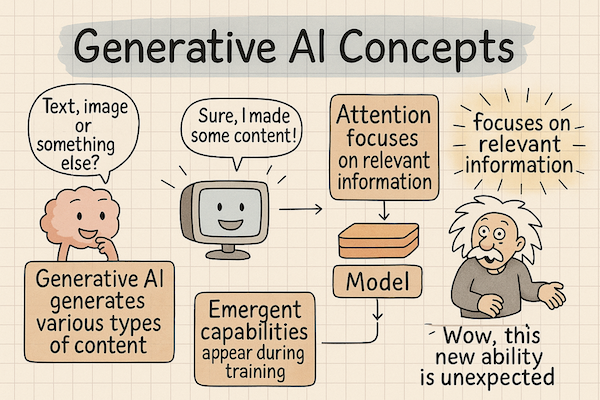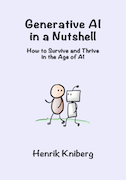
Generative AI Key Concepts, Limitations, and More!
Why Should You Care About Generative AI?
Imagine this: You’ve got Einstein, a master chef, a data scientist, and a stand-up comedian all hanging out in your basement, ready to help you with whatever you need. That’s Generative AI in a nutshell!
But wait—don’t start celebrating just yet. While Generative AI can be insanely powerful, it also comes with its quirks and flaws. Think of it as your new super-smart buddy who sometimes gets a little too confident—or just flat-out weird.
Ready to dive in? Let’s go head first into the concepts that make Generative AI tick and the limitations that keep it from being perfect.
Attention Mechanisms - AI’s Focus Superpower
What’s the Big Deal?
Imagine you’re at a concert, and everyone’s screaming. Yet, somehow, you zero in on the voice of your friend shouting, “They’re playing your song!” That’s attention—picking out the important bits and ignoring the noise.
Why Should You Care?
- Helps AI process long and complex text without getting lost.
- Makes the AI capable of distinguishing between subtle differences, like whether “bat” means the flying mammal or the baseball tool.
- Basically, attention is why modern AI doesn’t just spit out word soup.
Attention in Action:
Think about how ChatGPT generates long responses without losing coherence. That’s attention doing its magic—focusing on what matters and keeping the output on track.
Hot Take: Check out
Attention Is All You Needby Vaswani et al.—the brainy blueprint that sparked the Transformer revolution and made attention the AI superstar!
Reasoning - Coherent Thinking Before Blabbering
What’s the Deal?
Old models? They were like that friend who blurts out the first thing that comes to mind. Modern AI, though, takes a second to think it through. It’s like pausing before answering a tricky question. This coherence-oriented thinking makes AI responses more structured and logical.
Why Should You Care?
- Produces more coherent and logical responses, especially for complex problems.
- Less likely to give you a knee-jerk answer that makes no sense.
- Moves from being a “text generator” to a thoughtful problem solver.
Real-Life Scenario:
Imagine asking, “How do I file taxes as a freelancer?” Instead of just giving vague advice, reasoning models break down the steps logically and might even consider your location and income type.
Emergent Capabilities - Creative Surprises from AI
Wait, What Just Happened?
Imagine teaching your pet dog to fetch, but one day it walks into the kitchen and makes you a sandwich. That’s emergent capability—when AI suddenly shows creative skills that no one expected. These are unexpected abilities that go beyond just processing or predicting text.
Why Should You Care?
- Models trained for text start generating creative content like poetry or even coding.
- AI learns new skills on its own just by processing vast amounts of data.
- Your AI chatbot can suddenly become a storyteller or a creative assistant.
Mind-Blowing Example:
A language model trained to chat suddenly becomes amazing at composing music. It wasn’t designed for that—it just picked it up along the way from training data.
Prompt Engineering - Taming the Beast
Here’s the Trick:
Generative AI is like a genie—it’ll grant your wish, but you’d better be specific! Vague requests? You might just get nonsense. Crafting the right prompt is the difference between “Help me with my resume” and “Write a professional resume for a software developer with 5 years of experience.”
Prompt Engineering vs. Prompt Imagination
- Prompt Imagination: The creative process of coming up with ways to use Generative AI. It’s about what you can do with the model. Example: Realizing you can use an AI model as a brainstorming partner.
- Prompt Engineering: The technical craft of writing effective prompts to get the desired output. It’s about how you do it. Example: Asking an AI to act as a brainstorming coach and generate a list of innovative ideas.
Why Should You Care?
- Combining imagination with engineering gives you the best results.
- You’ll discover new applications for AI while also learning how to get the most accurate or creative responses.
- It’s not just about knowing the tool—it’s about being creative with it.
Pro Tips:
- Set the context: “Pretend you’re a marketing expert…”
- Be clear: “Summarize in three bullet points.”
- Use role-play: “You are an AI lawyer; draft a contract.”
- Imagine possibilities: “How could AI help me automate my weekly reports?”
Multimodal Models - More Than Just Words
What’s So Cool About It?
Think of AI that doesn’t just talk but can see, hear, and even generate videos. Yep, that’s multimodal AI—kind of like your digital Swiss Army knife.
Why Should You Care?
- You can show it a picture and ask questions about it.
- Convert voice notes to text without lifting a finger.
- Create videos from written scripts.
Human-AI Collaboration - Teamwork Makes the Dream Work
Why Team Up with AI?
Generative AI isn’t here to replace you—it’s here to help you be awesome. It’s like a co-pilot for creativity and productivity.
The Dark Side: Key Limitations and How to Mitigate Them
Cutoff Date: Living in the Past
- Problem: Generative AI models are trained on data up to a certain date, which means they lack knowledge of recent events.
- Mitigation: Use tools for real-time data retrieval, like integrating the model with search engines or knowledge bases. Clearly indicate the cutoff date when querying.
Lack of Memory: Goldfish Brain Syndrome
- Problem: Models can’t remember previous interactions, leading to inconsistent responses in long conversations.
- Mitigation: Use memory frameworks or conversational history management to maintain context. Break complex tasks into smaller sessions to minimize memory issues.
Hallucinations: Confidently Wrong
- Problem: Sometimes the model generates content that sounds plausible but is factually incorrect.
- Mitigation: Cross-check AI-generated information with reliable sources. Use AI models that include fact-checking modules or integrate real-time data verification tools.
Calculation Issues: Not a Math Genius
- Problem: Generative AI often struggles with accurate arithmetic and numerical reasoning.
- Mitigation: Combine AI with calculation tools or scripting environments to ensure numeric accuracy. Use models specifically trained for mathematical tasks.
Bias and Ethical Challenges: AI Can Be a Jerk
- Problem: Models can inadvertently reflect biases present in the training data.
- Mitigation: Regularly audit model outputs for bias. Implement bias mitigation techniques during training, like fine-tuning with diverse and balanced datasets.
Visualizing Generative AI Concepts and Limitations
Final Takeaway
Generative AI is a super-tool—but like any tool, you’ve got to know how to use it. Understand its strengths, acknowledge its limitations, and always keep your human brain in the loop.
Got a story of your AI being a genius—or a total goofball? Share it in the comments!
Quick Heads-Up: Generative AI in a Nutshell by Henrik Kniberg is sketch-packed and puzzle-driven—grab the book and dive into the course!
